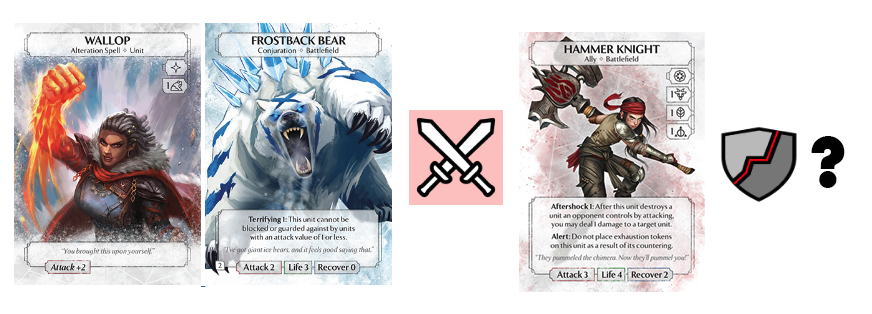Combat Mastery 1 - Tips to Improve Your Decision Making in Ashes Reborn.
By Timothy Cathcart
Ashes Reborn is fundamentally a game of combat and the battlefield. Many decks attempt to win by a mechanism other than the battlefield of course, milling out an opponents deck with Abundance, or burning your opponent directly with Molten Gold, but even then you still need to both plan and react to what's happening on the battlefield.
This “battlefield matters” aspect of the game is often what attracts players to the game. Depending on your deck’s victory condition it can be a great idea to play cards like Kneel and Nature’s Wrath to reduce the complexity of the board state and remove opportunities your opponent has to outplay you on the battlefield. However, even with those cards in your arsenal making good choices in how you play out combat is still usually critical to success.
Some basic advice for getting better at Ashes is quite easy to understand. Ensure you can spend all ten dice in your round one first five! Make sure your deck has a victory condition and perhaps even a plan B in different match-ups!
However getting better at the very fundamentals of ashes combat sequencing can be quite hard to nail down. When should you guard an attack? What unit should attack which enemy? When should you go all out and attack with everyone? These are questions that really depend on the state of the game.
In these articles I’ll try to give some concrete advice that will hopefully help you answer those questions as they show up in your games.
Tip 1: Identify Your Current Defensive and Aggressive Battlefield Priority.
Your opponent plays Wallop on their Frostback Bear and attacks your Hammer Knight. Should you guard the attack?
The answer is usually yes, but to understand the basics of why this is (and whenever this is not the case) you need to consider your current aggressive and defensive battlefield priority.
The aim of the game is to ultimately deal damage to your opponent’s PB, but how direct that goal relates to your decision making depends on the state of the game. If guarding an attack would kill your PB, obviously you can’t do it. What about leaving you 2 away from death, easily within Final Cry range?
Battlefield Dominance. This is often your default battlefield priority. The goal here is to destroy your opponents units without losing as many as yours. This will enable you to later on favourably convert your battlefield control into damage to the enemy’s PB. If you can dominate the battlefield you also prevent your opponent from executing a large plan of attack. Having powerful exhausted units that refresh at the start of the round when your opponent has none to match is often a good sign of who's winning a game of Ashes.
To play this priority aggressively, you should always make attacks against your opponents units, never their PB. Try to match your attack and costs against enemy units as efficiently as possible. Kill their 2 cost Winged Lioness with your 1 cost Seafoam Snapper and you just gained a 1 dice battlefield advantage.
Defensively you should guard the largest swing in attack and efficiency as possible. Your opponent just attacked with a 4 attack Frostback Bear against your Hammer Knight? Guard that attack and you just took a massive amount of damage out of the equation of battlefield dominance. Even if the damage you take is high and you’d rather have avoided the efficient opportunity for your opponent in the first place (the subject of the next combat tip) it still might be the right play.
On this flip side, if battlefield dominance is your aggressive priority you want to make it as awkward as possible when your opponent chooses to guard. Don’t over commit with a large attack against a low health unit. Your opponent may surprise you and guard the attack anyway.
PB Damage. Take everything you’ve learned about battlefield dominance and flip it on its head.
Aggressively prioritizing PB damage means calculating a good time to strike wide. If you out number your opponent’s unexhausted units, you can guarantee at least one of your attackers will make it through. Your deck may require more turns of setup but beware taking too long before swinging with everyone. You can use one PB guard to essentially exhaust a unit when they attack (forcing them to do this with Light Bringer is a classic aggressive move), but after that your opponent can start forcing your units into a dominance battle.
Knowing that your opponent will want to guard to protect a unit is also very important way to deal PB damage from the battlefield. Try attacking units with just a little more attack than is necessary and they may mistakenly guard the attack, falling into your aggressive plans.
 PB Damage Defence
PB Damage Defence
Defensively you should avoid guarding at all or guard only a small damage attack and start playing reactively to protect your PB’s life total. Your opponent may be caught off guard when you accept the death of an important unit but it might be worth it in the end. Attacking is risky since you’ll no longer have them as blockers. First build up a defence of couple unexhausted units so that you can make key attacks without worrying about massive counter swings against your PB.
My Advice.
My first piece of advice is to go big on your battlefield priority and make extreme plays with your guarding. If you are prioritizing dominance don’t be afraid to guard large attacks, they may win you battlefield control. If you are prioritizing PB health it can seem terrible to let your units die and not use your guard all round, or use it on a seemingly less important but less PB damaging attack, but that life total difference might be what wins you the game.
So when should you be prioritizing which battlefield goal?
Most “normal” battlefield based decks start with prioritizing battlefield dominance in round one before transitioning to defensive PB survival if their own life points get low, and transitioning to aggressive PB survival if their opponent's life points get low.
Its important to recognise that you can have a different aggressive and defensive battlefield priorities at the same time.
If your opponent’s life points drop to a low value before yours do, consider using your own health liberally to guard large attacks before pushing for the victory by aggressively swinging wide.
Some players are playing for domination almost the entire game, only attacking the PB directly when there is nothing left of their opponent’s to destroy. If you are trying to improve your standard battlefield game of Ashes, this is an excellent choice to focus on.
However, consider the following possibilities as well:
- If you are playing against a dedicated burn deck you may want to immediately prioritize protecting your PB health.
- If you are playing lots of aggressive units, you may wish to prioritize dealing PB health immediately, and even more aggressively, pair it with defensive dominance, sacrificing your own health to protect your units.
- If your opponent isn’t playing a burn plan but has access to burn cards, switch earlier from dominance to protecting your health to avoid losing while in control.
- If you’re on a slow mill plan, prioritize protecting your own PB health but try to play for battlefield dominance aggressively.
- If you are on burn plan, you want to protect your PB health but prioritize dealing your enemy PB damage at the same time.
These points of advice are up for debate and will change depending on your personal evaluation of the meta and the decks in the game. The potential for battlefield clog can also offer a unique twist to games, but I haven't covered that here.
Consider Your Priorities!
In summary my first tip for improving your combat skills for Ashes Reborn is as follows: Each round/turn ask yourself the question “Which is my aggressive priority here, PB health or battlefield dominance?” Then also ask yourself the question, “Which is defensive priority here?”




No comments to display
No comments to display